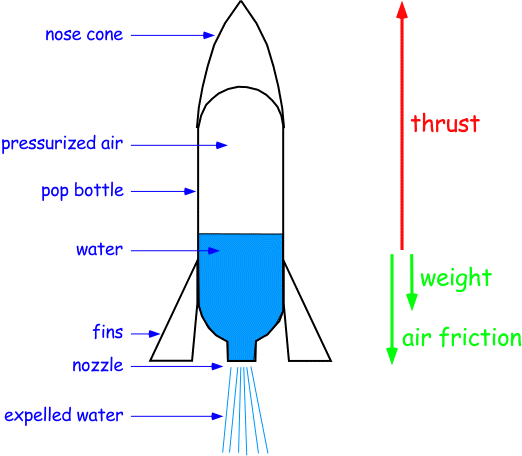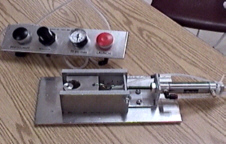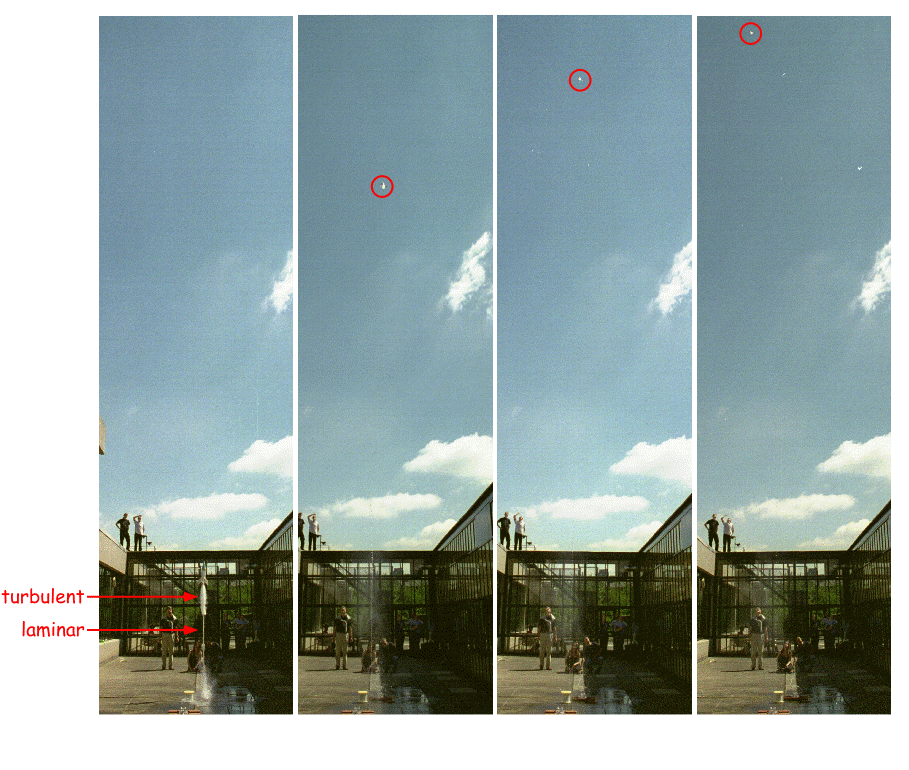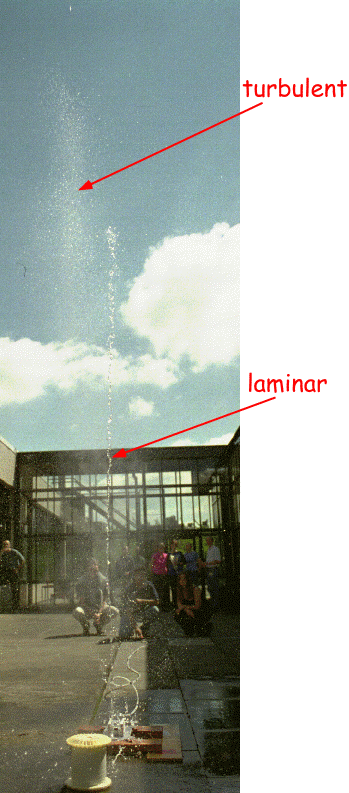The Leeds Water Rocket Page
Welcome to the Water Rocket page at the University of Leeds.
A simple rocket can be built of an empty Coke or lemonade plastic bottle. Partly filled with water and pressurized air the rocket can be blasted high up in the air. The pressurized air expells the water, which in turn creates the thrust to accelerate the rocket, counteracted by the air resistance and the weight of the rocket. Maximum speeds are up to 200 km/h and the world record height is more than 300 m!
Water Rockets are great fun! And they are very educational. You'll be amazed at the level of amusement children (of all ages) have in the world of Water Rocketry.

A Student's Project
This activity started out as a 3rd year project for physics students in the BSc Physics program at the Department of Physics and Astronomy
at the University of Leeds.
The students had the task to build a rocket from a pop bottle and find, for a given maximum pressure, the parameters for the shape and size of the bottle, the amount of water in it and the size of the outflow opening that would maximise the height reached.
They also performed a numerical simulation of the rocket flight, including the acceleration phase, the free-fly phase and effects of friction, that allowed to predict the performance of a given rocket configuration. At the end of the project the maximum height achieved as well as the agreement between experiment and simulation were assessed.
In this project a variety of physical effects and concepts are important such as the momentum conservation (rocket equation), energy conservation (kinetic, potential, pressure), acceleration, inert mass, air friction and others more. To model the flight of the rocket realisticly the three acting forces (thrust, drag and weight) have to be calculated for each point in time as they change in different phases of the flight.
How it works
With just a plain bottle and an initial pressure of about 6 bar heights of about 50 m can be reached. (The plastic soda bottles are designed to stand pressures of up to 12 bar.) Adding fins for stabilisation and a aerodynamically formed nose cone to reduce the air resistance, easily increases the maximum heights achievable by a factor of two or more. The world record at present is more than 300 m !!! Can you reach or even beat this?
Water rockets and Water Rockets Contest are very fashionable amongst children (of all ages) in the United States. In there classes at school they construct and optimise rockets which they then take once a year to local or national contests with other rocket enthusiasts.
Since the heights achieved are not easy to measure precisely, usually the time from launch to landing is measured. Thus, to increase the flight time, and also to prevent damage of the elaborate rockets, parachutes or wings are attached which unfold at the maximum height to initiate a slow and safe decent back to ground.
There are lots of sites on Water Rockets on the internet with photographs, explanations, simulations, informations on launchpads, fins, parachutes, multi-stage rockets, championships ... It's a real industry !
Water Rocket Summer Workshop at the University of Leeds, 6-7 July 2000
For about 25 students aged 15-17 in the Leeds area we ran a summer workshop on Water Rockets in July 2000. The rockets consisted of bottles with very simple fins and nose cones, the type even a novice to the field can produce in half hour. The maximum height reached was 72 m with 6 bar initial pressure. The height was measured with a thin thread connected to the rocket which was pulled off a reel during the ascent. The length of the thread was determined by weighing it on a precision balance.
By the way: our launch pads are fully pneumatic. They are connected to a small compressor and the rockets can be pressurised and launched by pressing a botton.

We bought them from Nerds Inc. in the US. There are many launch pads with varying sophistication and price on the market but it is not difficult to make yourself a simple one and use a good bicycle pump to create the pressure.
The rocket event was a great experience and everybody enjoyed it very much. Here are a few photgraphs taken with a camera with a fast winder in 0.25 s intervals. Some of the photographs reveal details that could not be seen with the naked eye.
Launch 1:
This series of images shows a flight of the rocket from start to culmination. One can see that the water expelled first flows out in a straight and narrow beam (laminar outflow). Towards the end of the 'burning phase' the water speed is getting so high that the outflow is turbulent and the water is expelled in a spray of air and water droplets which you can see as a white cloud right under the rocket.

Launch 2:
Also in this series of images the laminar and turbulent outflow are visible. At the end of the accelerating phase the rocket in only about 2-3 m high. Its velocity at this point is maximal and reaches up to 200 km/h. In the right image the thin white thread is visible that was used to determine the maximum height of the flight. It is pulled off the white reel next to the launchpad.



Launch 3:
The left image shows the rocket right after the launch. The water is still expelled at a high speed and the rocket just lifts of. In the second image the rocket is no longer visible, but there are two distinct clouds of droplets in the air. The first one (labelled "laminar") is well confined along the trajectory of the rocket and originates from the laminar outflow. The second one forms a spray of small droplets from the turbulent outflow phase.


Launch 4:
Here you see a rocket standing still at the launch pad. It is filled with about a third of water. The rest of the volume is pressurised air. This rocket has a very primitive nose cone made of the top of another bottle and a piece of styrofoam to sharpen it up a bit. The fins were made of a light-weight foam board attached to the bottle with hot glue.


Launch 5:
Here the laminar outflow is visible very nicely. There is only little water left in the bottle.















